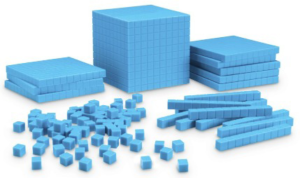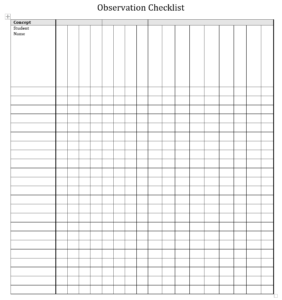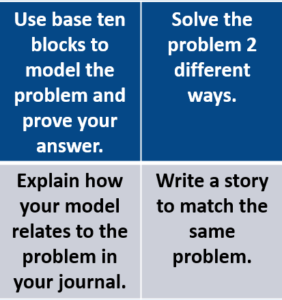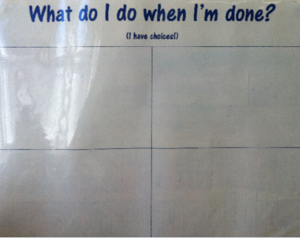What is differentiation in math?
Differentiation in math is responsive teaching that stems from teachers’ understanding of how teaching and learning occurs. Differentiation is responding to varied learners’ needs for more structure or more independence, more practice or greater challenge, and more active or less active approaches to learning.
3 main ways to differentiate:
1. Tools – the manipulatives or tools students use to solve a problem can be differentiated based on their level of understanding. For example: students that are at an enrich level may want to self-select their tools, core level students may be ready to draw a quick picture, where a re-teach level student may need to have a tool suggested to help them think through a problem or task. For example: All students may play fraction war to demonstrate an understanding of comparing fractions. Re-teach level students need to prove each answer with fraction tiles, core level students can draw a number line or quick picture, enrich level students will explain how they know their fraction is greater using missing pieces.
2. Tasks – differentiate what problems and tasks are posed. The ultimate goal is for all students to have an understanding of the learning goal by the end of the lesson, but the way they get to that understanding may look different. A problem’s numbers can be changed to make it less/more complex or the amount of writing in the problem could be differentiated.
3.Questions asked – pose questions that are adjusted to the level of complexity that meets a student’s readiness level. Questions should encourage students to do more than recall known facts. Questions should have the potential to stimulate thinking and reasoning. When using questions to differentiate, teachers need to plan tiered questions anticipating what may happen throughout a lesson.
Differentiation needs to be planned for and anticipated, but the teacher should be responsive during the lesson based on their informal assessments of the students’ level of understanding. Differentiation can occur when students are independently working, working with partners, or in small groups.
What are some ways to informally assess a student’s level of understanding?
There are different ways to quickly informally assess student understanding throughout the lesson. The easiest way is to pose a problem/task and use one of the strategies below to record each student’s level of understanding.
• Post-it notes – place 3-4 different post-it notes on a clipboard to signify the re-teach, core and enrich groups.
• Observation checklist – record specific details about the concept and use a plus, check, minus system to determine trends of student understanding of a concept.
• Students can self-assess – have students tell you their level of understanding with a smiley face/straight face/sad face system or color coded system.
• Code student journals – as the teacher is monitoring student work, place a colored dot or star/check/circle to signify which level of understanding a student has.
• Pass out a specific shape – pass out a pattern block shape based on the student’s level of understanding. (For example: Enrich – red trapezoid, Core – green triangle, Re-teach – blue rhombus)
• Exit tickets – use exit ticket problems from the day before to determine tiered small groups for the next day’s lesson.
Small groups may play a role in differentiating the three different ways. The math small groups should be fluid and recent informal assessments done by the teacher should help guide what support each individual student needs. Many teachers use the format below to make the transitions into small groups easy for differentiation. (The writing on the chart could be labeled for each group or color coded).
For parents: it’s important to know that sometimes your child’s work in math may look different than another student’s. The tools, tasks, questions, and level of support offered is to address the individual needs of the instruction for your child. Students may struggle with one math concept but be strong in another, so the differentiation will be fluid.
Teachers!!! For more information on differentiation, please visit the math differentiation mini professional development module located on your IDEAS math bulletin board.
Also visit these websites for more information on differentiating math instruction at http://165.139.150.129/intervention/Differentiated%20Instruction%20for%20Math.pdf or http://www.davidsongifted.org/Search-Database/entry/A10513.



